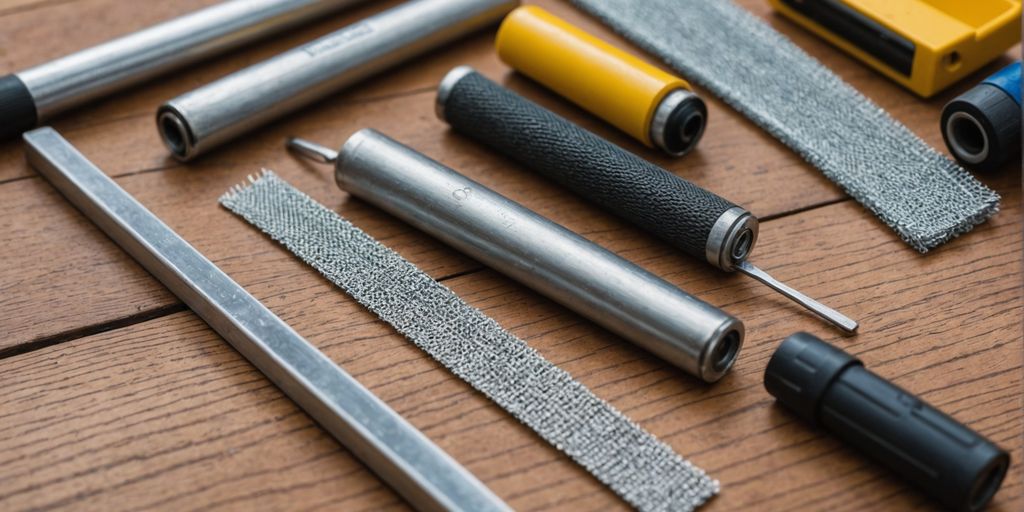
Essential Tools for Window Screen Repair Parts Replacement
Repairing window screens might seem tricky, but with the right tools and parts, it becomes much simpler. This guide will help you understand the different parts and tools you need for window screen repairs. Whether you're dealing with a torn screen or a loose frame, knowing what to do will make the job easier.
Key Takeaways
- Learn about the different parts needed for window screen repair, such as the frame, mesh, spline, and corner connectors.
- Discover how to choose the right screen mesh for your needs, including options like fiberglass, aluminum, pet-resistant, and solar screen mesh.
- Get a list of essential tools for window screen repair, including measuring tools, cutting tools, spline rollers, and screen patching kits.
- Follow a step-by-step guide to replacing a window screen, from removing the old screen to installing the new one and securing it with spline.
- Understand common issues in window screen repair and their solutions, like fixing tears, loose frames, worn-out spline, and broken corner connectors.
Understanding Window Screen Repair Parts
To fix a window screen, you need to know about the different parts involved. Each part has a specific role in making sure your screen works well and lasts a long time. Here are the main parts you should know about:
Types of Screen Materials
The screen material is the mesh that covers the frame. It can be made from different materials like fiberglass, aluminum, or even pet-resistant mesh. Each type has its own benefits and is suited for different needs.
Frame Components
The frame holds the screen material in place. It is usually made of aluminum or plastic. The frame needs to be strong to keep the screen tight and secure.
Spline and Spline Tools
The spline is a rubber or foam tubing that holds the screen material in the frame. Spline tools help you push the spline into the frame, making sure the screen stays in place.
Corner Connectors
Corner connectors join the frame pieces together. They are important for keeping the frame square and stable. Without good corner connectors, your frame could fall apart.
Knowing the parts of a window screen helps you choose the right window screen repair parts and tools. This makes the repair process easier and more effective.
Choosing the Right Screen Mesh
When it comes to replacing window screens, selecting the right mesh is crucial. Different types of mesh offer various benefits, from durability to visibility. Here are some common options to consider:
Fiberglass Mesh
Fiberglass mesh is the most popular choice for window screens. It's affordable and easy to install. This type of mesh is also resistant to rust and corrosion, making it a long-lasting option.
Aluminum Mesh
Aluminum mesh is known for its strength and durability. It's a bit more expensive than fiberglass but offers better resistance to damage. This mesh is ideal for areas with high traffic or where pets might come into contact with the screen.
Pet-Resistant Mesh
If you have pets, pet-resistant mesh is a great option. This type of mesh is designed to withstand claws and other potential damage from animals. It's thicker and more durable than standard mesh, ensuring a longer lifespan.
Solar Screen Mesh
Solar screen mesh is designed to block out a significant amount of sunlight, helping to keep your home cooler. This type of mesh can also protect your furniture from fading due to sun exposure. It's a bit more expensive but offers excellent benefits for homes in sunny areas.
Essential Tools for Window Screen Repair
When it comes to fixing window screens, having the right tools is crucial. These tools make the job easier and ensure a professional finish. Here are the essential tools you'll need for window screen repair:
Measuring Tools
Accurate measurements are key to a successful repair. A good tape measure will help you get the exact dimensions of your screen frame and mesh. Make sure to measure twice to avoid mistakes.
Cutting Tools
You'll need sharp cutting tools to trim the screen mesh and frame components. Utility knives and heavy-duty scissors are perfect for this task. Always cut slightly larger than needed and trim down for a perfect fit.
Spline Rollers
Spline rollers are used to press the spline into the frame, securing the screen mesh. These tools come in various sizes, so choose one that matches your spline. A good spline roller ensures the mesh is tight and secure.
Screen Patching Kits
For minor repairs, screen patching kits are very handy. These kits usually include small patches of screen material and adhesive. They are perfect for fixing small tears and holes without replacing the entire screen.
Having the right tools not only makes the job easier but also ensures a professional and long-lasting repair.
Step-by-Step Guide to Replacing Window Screens
Replacing a window screen might seem tricky, but with the right steps, it's a breeze. Follow this step-by-step guide to get your window looking new again.
Common Issues and Solutions in Window Screen Repair
Window screens can face a variety of issues over time. Here are some common problems and their solutions to help you keep your screens in top shape.
Tears and Holes in Screen Mesh
Tears and holes are among the most frequent problems with window screens. These can be caused by weather, pets, or other external factors. To fix small tears or holes, you can use a screen patch kit. For larger damages, it might be best to replace the entire screen mesh.
Loose or Damaged Frames
Loose or damaged frames can make your window screens ineffective. This issue often arises from wear and tear over time. To fix this, you can tighten the frame screws or replace the damaged parts. If the frame is beyond repair, consider getting a new one.
Worn-Out Spline
The spline is the rubber or foam tubing that holds the screen material in place. Over time, the spline can wear out, causing the screen to become loose. Replacing the spline is a simple fix that can restore the screen's functionality. Make sure to choose the right size and type of spline for your screen.
Broken Corner Connectors
Corner connectors join the frame pieces together. If these break, the frame can become unstable. Replacing broken corner connectors is essential for maintaining the integrity of the screen frame. You can find replacement connectors at most hardware stores.
Regular maintenance of your window screens can extend their lifespan, saving you money in the long run. It also enhances your home’s ventilation while keeping pests at bay, contributing to a healthier living environment.
Maintenance Tips for Prolonging Window Screen Life
Regular Cleaning
Regularly cleaning your window screens can prevent dirt and debris from building up, ensuring optimal airflow and visibility. Use a mild detergent and water to gently scrub the mesh, then rinse thoroughly and allow it to dry completely before re-installing.
Inspecting for Damage
Periodically inspect your window screens for any signs of damage or wear. Look for tears, holes, or loose frames. If you notice any issues, they can be patched using a screen repair kit or replaced entirely if necessary.
Proper Storage During Off-Season
When not in use, especially during the off-season, store your window screens properly to avoid damage. Lay them flat in a dry, safe place to prevent bending or warping. Proper storage can significantly extend the lifespan of your screens.
Regular maintenance of your window screens can extend their lifespan, saving you money in the long run. It also enhances your home’s ventilation while keeping pests at bay, contributing to a healthier living environment.
Using Protective Coatings
Applying protective coatings can help shield your window screens from the elements. These coatings can prevent rust and corrosion, especially on metal screens, and can also make cleaning easier. Be sure to follow the manufacturer's instructions for the best results.
Conclusion
Repairing your window screens doesn't have to be a daunting task. With the right tools and parts, you can easily fix any damage and keep your home comfortable and pest-free. From choosing the right screen mesh to using the proper tools, each step is important to ensure a successful repair. By following the tips and guidelines provided in this article, you'll be well-equipped to handle any window screen repair project. Remember, a well-maintained window screen not only improves your home's appearance but also enhances its functionality. So, take the time to invest in quality parts and tools, and enjoy the benefits of a job well done.
Frequently Asked Questions
What materials are commonly used for window screen mesh?
Window screen mesh is often made from materials like fiberglass, aluminum, pet-resistant fabric, and solar screen mesh. Each type has different benefits, such as durability and protection against pets or sun rays.
How do I know which screen mesh to choose?
The choice depends on your needs. Fiberglass is common and affordable, aluminum is strong, pet-resistant mesh is durable for homes with pets, and solar screen mesh helps block sunlight.
What tools do I need to repair a window screen?
You'll need measuring tools, cutting tools, spline rollers, and screen patching kits. These tools help you measure, cut, and secure the new screen material in place.
How do I remove the old screen from the window frame?
To remove the old screen, use a flathead screwdriver to lift the spline out of its groove. Once the spline is out, gently pull the old screen away from the frame.
What are common issues with window screens?
Common issues include tears and holes in the mesh, loose or damaged frames, worn-out spline, and broken corner connectors. Each problem requires specific repair techniques.
How often should I clean and inspect my window screens?
It's a good idea to clean and inspect your window screens at least twice a year. Regular maintenance helps prolong their life and ensures they remain effective in keeping pests out.
